 |
| Col. James Phillip Fleming, USAF, Medal of Honor, Born Sedalia, MO 1943 James P. Fleming Youtube / Medal of Honor |
James Phillip Fleming (born March 12, 1943) was a United States Air Force pilot in the Vietnam War. Born in Sedalia, Missouri, he was awarded the Medal of Honor for rescuing a six-man MACV-SOG Recon Team, stranded between heavily defended enemy positions, near Đức Cơ, Vietnam.
Biography
Born 12 March 1943 in Sedalia, Missouri, Fleming entered military service at Pullman, Washington. In 1968, he was an aircraft commander of a UH-1F transport helicopter assigned to the 20th Special Operations Squadron at East Airfield in the Republic of Vietnam.
On November 26, a six-man reconnaissance team of Army Special Forces Green Berets had been lifted into Vietnam's western highlands, near the Cambodian border and about 30 miles (48 km) west of Pleiku. Hours later, they found themselves penned up next to a river, with enemy forces on the three remaining sides. The team leader's call for immediate evacuation was received by an Air Force forward air controller (FAC), Major Charles E. Anonsen, as well as Fleming's nearby flight of five UH-1s. All five helicopters, despite being low on fuel, headed toward the coordinates while the FAC briefed them on the situation.
The Green Berets were taking heavy fire from six heavy machine guns and an undetermined number of enemy troops. As soon as the helicopters sighted the team's smoke, the gunships opened fire, knocking out two machine gun positions. One gunship was hit and crash-landed across the river, its crew picked up by another of the transports. A second transport, low on fuel, had to pull out of formation and return to base. There were only two helicopters left, Fleming's and one other that was almost out of ammunition.
Hovering just above the jungle treetops, Fleming inspected the only clearing near enough for the troops to reach and found it impossible to land there. He instead flew over the river and hovered just above the water, with his landing skids against the bank, hoping that the special forces troops would be able to run the few yards to his helicopter safely. In addition to exposing his aircraft to ground fire, this maneuver was a balancing act that required great piloting skill. After waiting for several minutes, the reconnaissance team radioed that they couldn't survive a dash to the helicopter. Fleming lifted his UH-1 out of range of the hostile fire.
The FAC directed the Green Berets to detonate their mines as Fleming made a last attempt to rescue them. As the mines exploded, he again lowered his helicopter to the river bank, balancing against it, giving the Green Berets an open cargo door through which to leap to safety. The enemy soldiers concentrated their fire on the UH-1. The Green Berets ran for the chopper, firing as they ran and killing three Viet Cong barely 10 feet (3.0 m) from the aircraft. As they leaped through the cargo door, Fleming once more backed the helicopter away from the bank and flew down the river to safety.
In a ceremony at the White House on May 14, 1970, President Richard Nixon presented the Medal of Honor to Fleming for his actions during the rescue. Fleming's other decorations include the Silver Star, the Distinguished Flying Cross and eight Air Medals.
Fleming remained in the Air Force, becoming a colonel and a member of the Officer Training School staff at Lackland Air Force Base, Texas, before his retirement in 1996.
For conspicuous gallantry and intrepidity in action at the risk of his life above and beyond the call of duty. Capt. Fleming (then 1st Lt.) distinguished himself as the Aircraft Commander of a UH-1F transport Helicopter. Capt. Fleming went to the aid of a 6-man special forces long range reconnaissance patrol that was in danger of being overrun by a large, heavily armed hostile force. Despite the knowledge that 1 helicopter had been downed by intense hostile fire, Capt. Fleming descended, and balanced his helicopter on a river bank with the tail boom hanging over open water. The patrol could not penetrate to the landing site and he was forced to withdraw. Dangerously low on fuel, Capt. Fleming repeated his original landing maneuver. Disregarding his own safety, he remained in this exposed position. Hostile fire crashed through his windscreen as the patrol boarded his helicopter. Capt. Fleming made a successful takeoff through a barrage of hostile fire and recovered safely at a forward base. Capt. Fleming's profound concern for his fellowmen, and at the risk of his life above and beyond the call of duty are in keeping with the highest traditions of the U.S. Air Force and reflect great credit upon himself and the Armed Forces of his country.
Biography
Born 12 March 1943 in Sedalia, Missouri, Fleming entered military service at Pullman, Washington. In 1968, he was an aircraft commander of a UH-1F transport helicopter assigned to the 20th Special Operations Squadron at East Airfield in the Republic of Vietnam.
On November 26, a six-man reconnaissance team of Army Special Forces Green Berets had been lifted into Vietnam's western highlands, near the Cambodian border and about 30 miles (48 km) west of Pleiku. Hours later, they found themselves penned up next to a river, with enemy forces on the three remaining sides. The team leader's call for immediate evacuation was received by an Air Force forward air controller (FAC), Major Charles E. Anonsen, as well as Fleming's nearby flight of five UH-1s. All five helicopters, despite being low on fuel, headed toward the coordinates while the FAC briefed them on the situation.
The Green Berets were taking heavy fire from six heavy machine guns and an undetermined number of enemy troops. As soon as the helicopters sighted the team's smoke, the gunships opened fire, knocking out two machine gun positions. One gunship was hit and crash-landed across the river, its crew picked up by another of the transports. A second transport, low on fuel, had to pull out of formation and return to base. There were only two helicopters left, Fleming's and one other that was almost out of ammunition.
Hovering just above the jungle treetops, Fleming inspected the only clearing near enough for the troops to reach and found it impossible to land there. He instead flew over the river and hovered just above the water, with his landing skids against the bank, hoping that the special forces troops would be able to run the few yards to his helicopter safely. In addition to exposing his aircraft to ground fire, this maneuver was a balancing act that required great piloting skill. After waiting for several minutes, the reconnaissance team radioed that they couldn't survive a dash to the helicopter. Fleming lifted his UH-1 out of range of the hostile fire.
The FAC directed the Green Berets to detonate their mines as Fleming made a last attempt to rescue them. As the mines exploded, he again lowered his helicopter to the river bank, balancing against it, giving the Green Berets an open cargo door through which to leap to safety. The enemy soldiers concentrated their fire on the UH-1. The Green Berets ran for the chopper, firing as they ran and killing three Viet Cong barely 10 feet (3.0 m) from the aircraft. As they leaped through the cargo door, Fleming once more backed the helicopter away from the bank and flew down the river to safety.
In a ceremony at the White House on May 14, 1970, President Richard Nixon presented the Medal of Honor to Fleming for his actions during the rescue. Fleming's other decorations include the Silver Star, the Distinguished Flying Cross and eight Air Medals.
Fleming remained in the Air Force, becoming a colonel and a member of the Officer Training School staff at Lackland Air Force Base, Texas, before his retirement in 1996.
Medal of Honor citation
Fleming's official Medal of Honor citation reads: For conspicuous gallantry and intrepidity in action at the risk of his life above and beyond the call of duty. Capt. Fleming (then 1st Lt.) distinguished himself as the Aircraft Commander of a UH-1F transport Helicopter. Capt. Fleming went to the aid of a 6-man special forces long range reconnaissance patrol that was in danger of being overrun by a large, heavily armed hostile force. Despite the knowledge that 1 helicopter had been downed by intense hostile fire, Capt. Fleming descended, and balanced his helicopter on a river bank with the tail boom hanging over open water. The patrol could not penetrate to the landing site and he was forced to withdraw. Dangerously low on fuel, Capt. Fleming repeated his original landing maneuver. Disregarding his own safety, he remained in this exposed position. Hostile fire crashed through his windscreen as the patrol boarded his helicopter. Capt. Fleming made a successful takeoff through a barrage of hostile fire and recovered safely at a forward base. Capt. Fleming's profound concern for his fellowmen, and at the risk of his life above and beyond the call of duty are in keeping with the highest traditions of the U.S. Air Force and reflect great credit upon himself and the Armed Forces of his country.
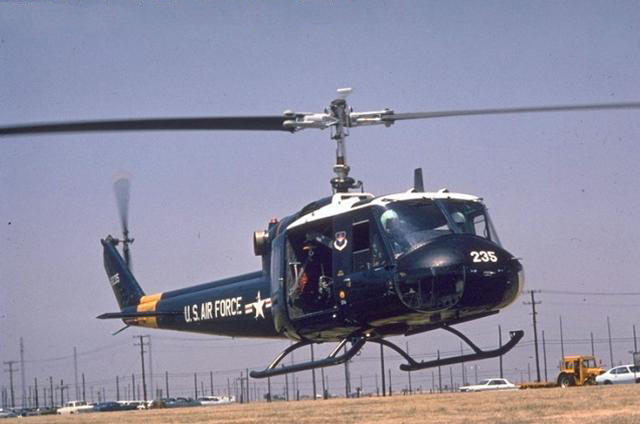 The UH-1F was originally tasked with supporting Strategic Air Command ICBM missile bases. This helicopter, 66-1235, c/n 7311, was sent to The Boneyard at Davis-Monthan AFB, Arizona, in 1977. It was later registered as a restricted civil aircraft, VH-LIP, used for aerial firefighting by McDermott Aviation, Queensland, Australia, (U.S. Air Force) The Bell UH-1F Iroquois (best known as the “Huey”) was was unique to the U.S. Air Force and was initially intended for missile base support. It used the airframe of the UH-1B (Bell Model 204), combined with the 48-foot-diameter main rotor system, transmission and longer tail boom of the UH-1D (Model 205). The Air Force required that it be re-engined to use the General Electric T58-GE-3 turboshaft engine. This was the same engine used in the Sikorsky HH-3E and commonality was desirable, but the T58 was also much more powerful than the Lycoming T53 engine of the UH-1B and UH-1D. The use of the T58 gave the UH-1F/P the distinctive side exhaust exit that identifies it from other Huey variants.
The UH-1F was originally tasked with supporting Strategic Air Command ICBM missile bases. This helicopter, 66-1235, c/n 7311, was sent to The Boneyard at Davis-Monthan AFB, Arizona, in 1977. It was later registered as a restricted civil aircraft, VH-LIP, used for aerial firefighting by McDermott Aviation, Queensland, Australia, (U.S. Air Force) The Bell UH-1F Iroquois (best known as the “Huey”) was was unique to the U.S. Air Force and was initially intended for missile base support. It used the airframe of the UH-1B (Bell Model 204), combined with the 48-foot-diameter main rotor system, transmission and longer tail boom of the UH-1D (Model 205). The Air Force required that it be re-engined to use the General Electric T58-GE-3 turboshaft engine. This was the same engine used in the Sikorsky HH-3E and commonality was desirable, but the T58 was also much more powerful than the Lycoming T53 engine of the UH-1B and UH-1D. The use of the T58 gave the UH-1F/P the distinctive side exhaust exit that identifies it from other Huey variants.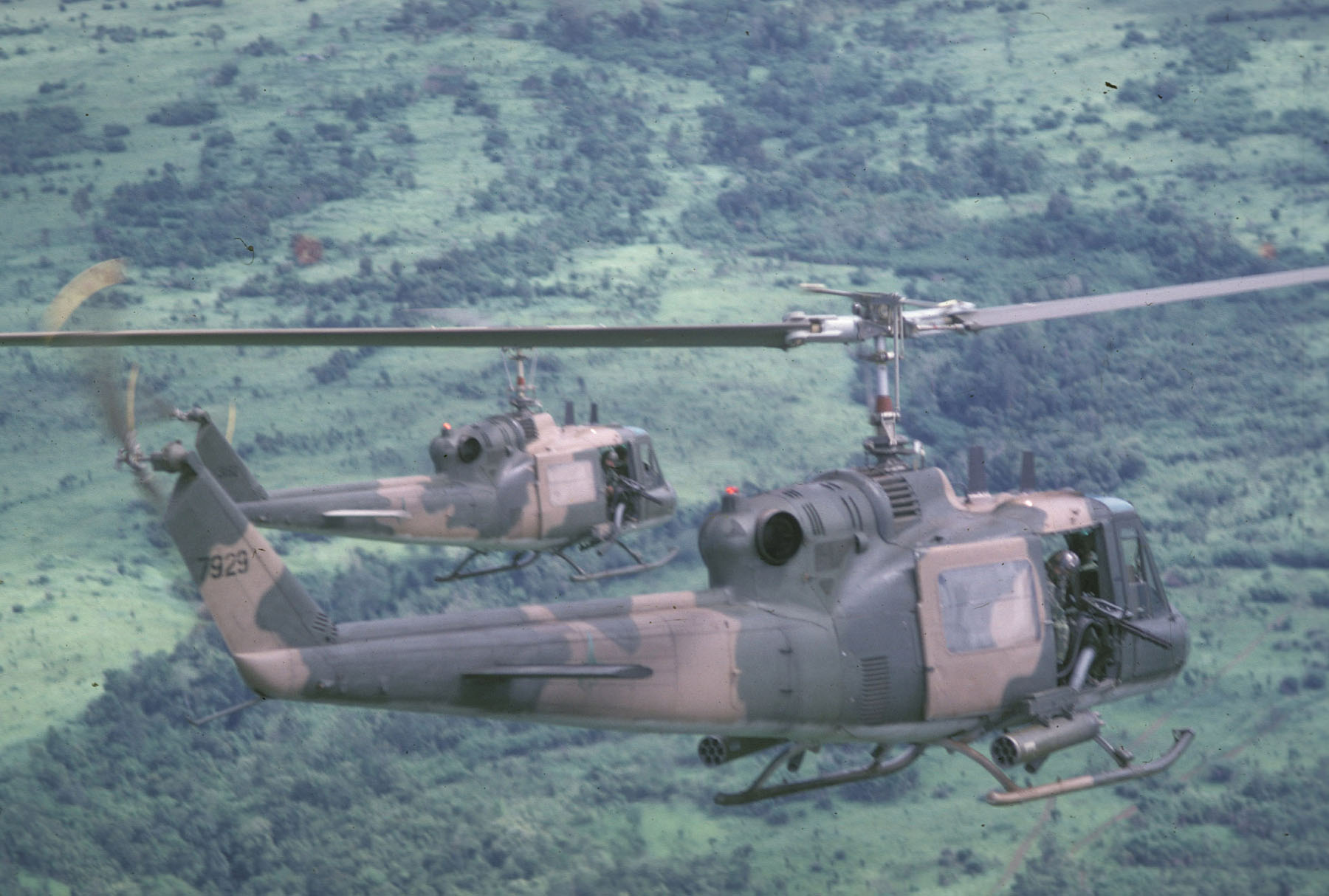 Two U.S. Air Force UH-1P Hueys of the 20th Special Operations Squadron, the “Green Hornets.” 65-7929 is closer to camera. The second Huey is 63-13162. Both helicopters are armed with two door-mounted M93 7.65 mm “miniguns” systems: electrically-driven M134 rotary machine guns capable of a 4,000 round-per-minute rate of fire. On each side of 7929 are 7-tube rocket launchers for 2.75-inch (70 mm) FFAR rockets. (Captain Billie Dee Tedford, United States Air Force) 119 UH-1Fs were built by the Bell Helicopter Co., Fort Worth, Texas. A single-engine, medium-lift helicopter, it is configured to be operated by a pilot and co-pilot and can carry 10 passengers. The first aircraft, originally designated XH-48, s/n 63-13141, made its first flight 20 February 1964. The first production UH-1F was delivered to the Air Force 23 September 1964. Twenty UH-1Fs were modified to UH-1P as special operations helicopters.
Two U.S. Air Force UH-1P Hueys of the 20th Special Operations Squadron, the “Green Hornets.” 65-7929 is closer to camera. The second Huey is 63-13162. Both helicopters are armed with two door-mounted M93 7.65 mm “miniguns” systems: electrically-driven M134 rotary machine guns capable of a 4,000 round-per-minute rate of fire. On each side of 7929 are 7-tube rocket launchers for 2.75-inch (70 mm) FFAR rockets. (Captain Billie Dee Tedford, United States Air Force) 119 UH-1Fs were built by the Bell Helicopter Co., Fort Worth, Texas. A single-engine, medium-lift helicopter, it is configured to be operated by a pilot and co-pilot and can carry 10 passengers. The first aircraft, originally designated XH-48, s/n 63-13141, made its first flight 20 February 1964. The first production UH-1F was delivered to the Air Force 23 September 1964. Twenty UH-1Fs were modified to UH-1P as special operations helicopters.The fuselage of the UH-1F/UH-1P is 44 feet, 7 inches (13.589 meters) long. With blades turning, the overall length of the helicopter is 57 feet, 1 inch (17.399 meters), and it is 14 feet, 11 inches (4.547 meters) high. The main rotor has a diameter of 48 feet, 0 inches (14.630 meters) and turns counter-clockwise as seen from above. (The advancing blade is on the right.) The tail rotor has a diameter of 8 feet, 6 inches (2.591 meters) and is mounted on the left side of the tail boom in a pusher configuration. It turns counter-clockwise as seen from the helicopter’s left. (The advancing blade is above the tail rotor’s axis of rotation.)
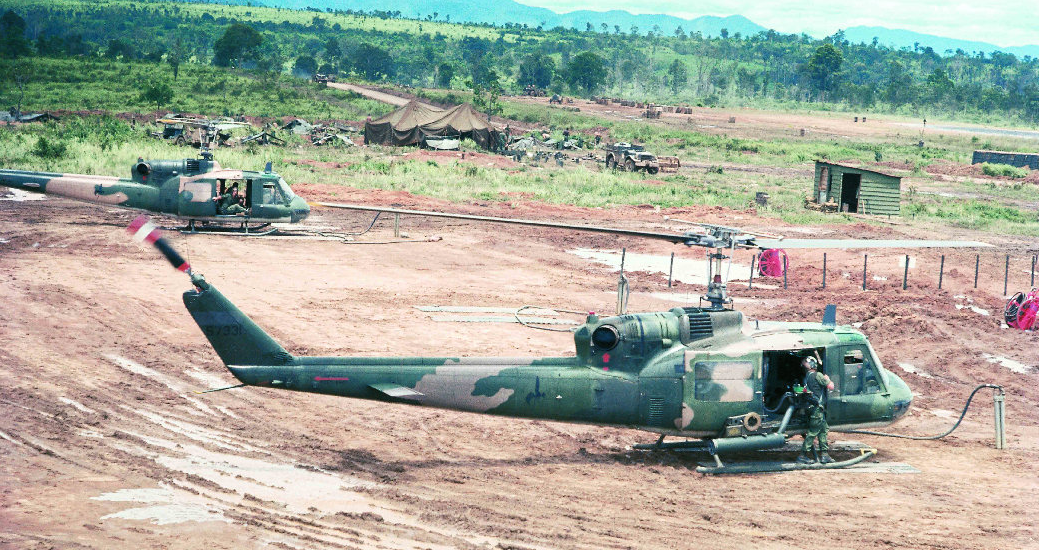 20th Special Operations Squadron UH-1P Hueys refueling at Đắk Tô, Central Highlands, Vietnam. (Don Joyce) The UH-1F has an empty weight of 4,403 pounds (1,997.2 kilograms), and its maximum gross weight is 9,000 pounds (4,082.3 kilograms).
20th Special Operations Squadron UH-1P Hueys refueling at Đắk Tô, Central Highlands, Vietnam. (Don Joyce) The UH-1F has an empty weight of 4,403 pounds (1,997.2 kilograms), and its maximum gross weight is 9,000 pounds (4,082.3 kilograms).The UH-1F is powered by a single General Electric T58-GE-3 turboshaft engine. The T58 is an axial-flow engine with a 10-stage compressor, single combustion chamber and 3-stage turbine (2 low- and 1 high-pressure stages. The low-pressure turbine drives the compressor, with a maximum speed of 26,300 r.p.m. (N1). The high pressure turbine drives the engine’s output shaft, with a maximum r.p.m. of 19,500 r.p.m. (N2). The T-58-GE-3 is rated at 1,070 shaft horsepower, but is capable of producing 1,325 shaft horsepower. The T58 is 4 feet, 7 inches (1.397 meters) long, 1 foot, 8.2 inches (0.513 meters) in diameter, and weighs 305 pounds (138 kilograms).
The UH-1F/P has a maximum speed of 138 miles per hour (222 kilometers per hour), with a normal cruise speed of 123 miles per hour (198 kilometers per hour). It can lift a 4,000 pound (1,814 kilogram) payload. The helicopter has a service ceiling of 24,830 feet (7,568 meters), can hover out of ground effect (HOGE) at 15,700 feet (4,785 meters) and in ground effect (IGE) at 18,700 feet (5,700 meters). With maximum fuel, its range is 392 miles (631 kilometers).
UH-1F and UN-1P helicopters remained in service with the Air Force until the early 1980s when their mission was taken over by the twin-engine UH-1N (Bell Model 212).
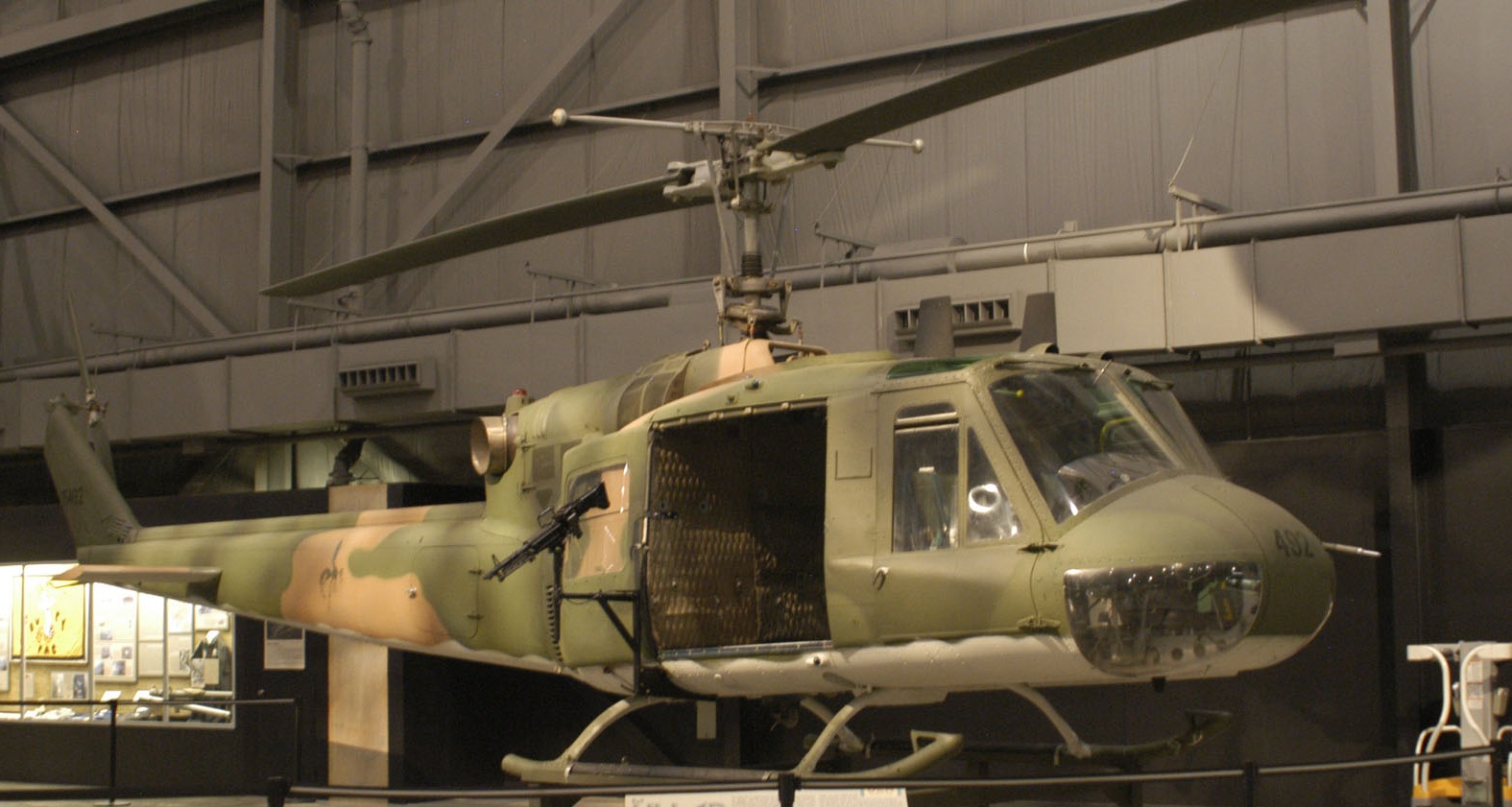 Bell Helicopter Corp. UH-1P Iroquois (converted from UH-1F-BF) serial number 64-15476, marked as 1LT James Fleming’s UH-1F, 64-15492, which he was flying during the action of 26 November 1968. The “Green Hornet” of the 20th Special Operations Squadron is painted on the helicopter’s tail boom. The actual 64-15492 (c/n 7042) was shot down 13 February 1969.
Bell Helicopter Corp. UH-1P Iroquois (converted from UH-1F-BF) serial number 64-15476, marked as 1LT James Fleming’s UH-1F, 64-15492, which he was flying during the action of 26 November 1968. The “Green Hornet” of the 20th Special Operations Squadron is painted on the helicopter’s tail boom. The actual 64-15492 (c/n 7042) was shot down 13 February 1969. 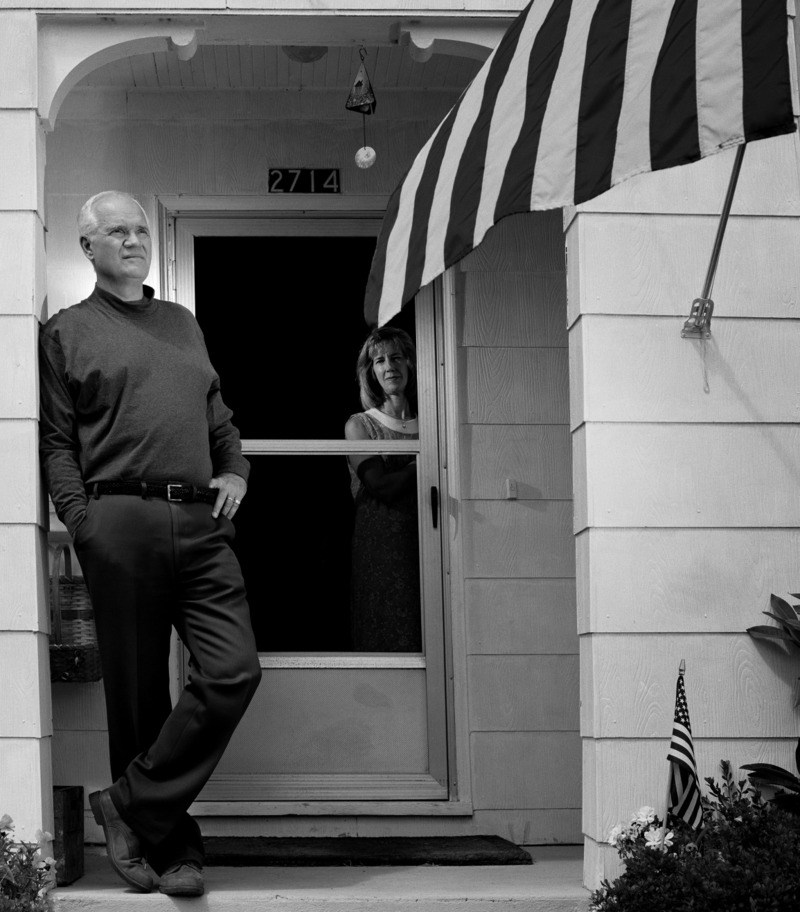 Colonel James P. Fleming, U.S. Air Force (Retired) and Mrs. Fleming. (MSNBC)© 2016, Bryan R. Swopes
Colonel James P. Fleming, U.S. Air Force (Retired) and Mrs. Fleming. (MSNBC)© 2016, Bryan R. Swopes




No comments:
Post a Comment